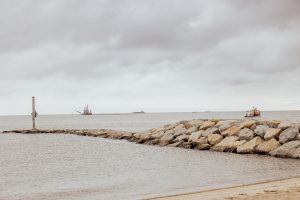A bulldozer spreads beneficially-reused sand from DNREC’s Murderkill River emergency dredging project on South Bowers beach on Aug. 11 while the DNREC contractor’s dredge in background continues to clear the navigation channel.
An emergency dredging project to restore navigability in the Murderkill River was completed ahead of schedule, the Delaware Department of Natural Resources and Environmental Control announced today – with momentum from the $2.3 million project expected to carry over into fall on additional dredging work by DNREC’s Shoreline and Waterway Management Section that includes another navigability restoration challenge on White Creek in Sussex County.
The $2.3 million Murderkill project dredged more than 52,000 cubic yards of sediment from the river’s navigation channel, with DNREC making beneficial reuse of the dredged material to nourish close to a quarter-mile of eroding shoreline at South Bowers Beach. Not only was this accomplished during a continuous two-week dredging effort, but an additional 200 feet of sandy material was located in the Murderkill channel by DNREC’s contractor, Cottrell Contracting Company – which meant more volume could be pumped ashore to South Bowers for enhancing the town’s resiliency to coastal storms. That aspect of the project was not to be understated with the additional sand extending an area of an earlier beach nourishment project that also used dredged sand to bolster the shoreline as a vital defense of the coastal community against extreme weather.

Starting Aug. 2, DNREC’s contractor worked 24/7 on the project – with the dredge clearing the Murderkill navigation channel by mid-August as verified by surveys collected by a third party. Cottrell Contracting also monitored the dredging work for turbidity throughout the project to ensure compliance with water quality rules and regulations.
The project – which the contractor originally estimated for a 19-day work duration, based on an average rate of production – beat that estimate to the finish line by six days, in large part due to favorable weather conditions throughout. While the weather all but fully cooperated, Cottrell Contracting still had to dredge and pump sand ashore through a tide range about as large as it gets on Delaware Bay, with almost 7 feet of difference between high and low tides on some days. Within a span of two weeks, the Murderkill River – a federally-authorized navigation project that requires periodic dredging to maintain the safety of and navigable access to the river – had the open channel critically important to commercial and emergency vessels as well as recreational boating.
“DNREC’s Waterway Management Program is pleased with the completion and outcome of the Murderkill project, as well as the Delaware City Mooring Basin dredging project, which also was completed near the end of August,” said DNREC Shoreline and Waterway Management Section administrator Jesse Hayden. “We aim to keep momentum going from these two important dredging projects by today publishing a bid opportunity for dredging at White Creek, and as we continue the engineering phase of several other waterway projects to be undertaken by DNREC in the near future.”
About DNREC
The Delaware Department of Natural Resources and Environmental Control protects and manages the state’s natural resources, protects public health, provides outdoor recreational opportunities and educates Delawareans about the environment. The DNREC Division of Watershed Stewardship develops and implements innovative watershed assessment, monitoring and implementation activities. For more information, visit the website and connect with @DelawareDNREC on Facebook, Twitter or LinkedIn.
Media contacts: Michael Globetti, michael.globetti@delaware.gov or Nikki Lavoie, nikki.lavoie@delaware.gov
